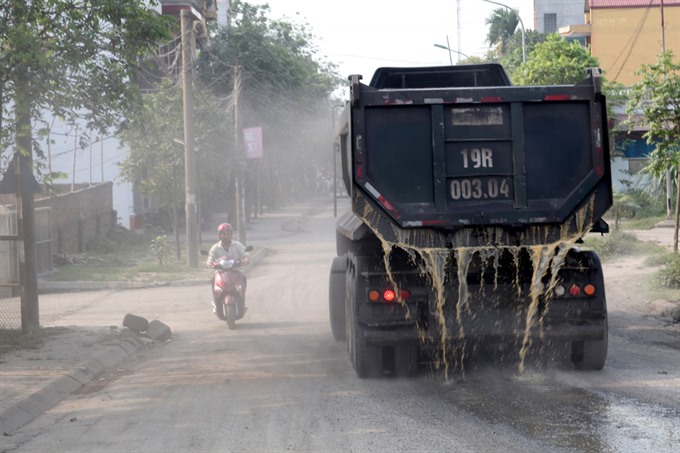 Society
Society

Last year, Hà Nội and HCM City had more than 120 days when the air quality was polluted beyond the health standards set by the World Health Organisation, according to a report released yesterday.
 |
| Dust is kicked up by a truck on a section of a local road in Hà Nội’s Thanh Trì District. — VNA/VNS Photo Trung Kiên |
HÀ NỘI —Last year, Hà Nội and HCM City had more than 200 days when the air quality was polluted beyond the health standards set by the World Health Organisation, according to a report released yesterday.
The annual report on Việt Nam’s air quality, conducted by a non-Government organisation, GreenID, is one of the few to shed light on how dirty the air is in the two most populated cities. Many say the Government has not yet paid enough attention to the situation.
The report mainly analysed the real-time air quality index (AQI) collected by the United States embassy and consulate in the two cities.
Hà Nội was reported to have a yearly average AQI of 103 – meaning that the air quality is acceptable for most, but considered unhealthy for sensitive groups, including children, the elderly and people with lung or heart diseases.
However, the heavy concentration of the dangerous, particulate matter PM2.5 in the air has raised real health alarms in most city people.
PM2.5 refers to the tiny dust particles that are two and one half microns or less in width, or about 30 times smaller than that of a human hair. Those particles, which can remain longer and spread farther in the air than normal dust, are able to travel deep into the lungs and eventually into the blood.
The average PM2.5 level of the capital last year reached 42.6, far exceeding the national standard of 25, let alone the level recommended by the WHO at 10 to sustain safe air for the people, according to the report.
On a daily basis, Hà Nội had 99 days in 2017 breaking the national red line and 257 days beyond the international bar.
“We, however, still saw a positive improvement regarding air quality in Hà Nội. The average percentage of good and moderate hourly AQI in 2017 reached more than 50 per cent, while that in 2016 was only about 36 per cent,” said a GreenID researcher Nguyễn Thị Anh Thư.
Air quality in HCM City was slightly better than Hà Nội, with the average AQI reaching 87 – a moderate quality – but the yearly particle concentration at 29.6 still exceeded both the national and the WHO standards.
The southern hub was reported to have 14 days that violated national regulations and up to 222 days that broke WHO guidelines.
Việt Nam was not the only country where the US embassy measured the PM2.5 concentration. Hà Nội’s level was found to be far behind that of New Delhi and Mumbai, which emerged as the new global air pollution hotspots, but was approaching the notorious Beijing.
Beijing’s average particle concentration in 2017 reached 45.9, just three points higher than Hà Nội’s.
It might not be a coincidence that most of the polluted airflow which brought the particle pollutants to Hà Nội passed through Quảng Ninh Province, the region famous for its coal industry and seven thermal power plants, according to the report.
Dr Lê Việt Phú from Fulbright University Việt Nam argued that there were two prices that had to be adjusted to tackle air pollution - for fossil-fuel power and petrol.
While Việt Nam is increasingly relying on thermal power to provide electricity, electricity prices are remarkably low compared to many other countries, Phú said.
“It is at around seven US cents per kW. With that low price (of thermal power), Việt Nam will not be able to develop alternative clean energy like solar or wind power,” he said.
He also suggested a tax ranging between VNĐ3-8,000 (1-3 US cents) on petrol to make up for the air pollution caused by the vehicles, “as long as the Government is transparent about the spending of the money”.
“Air pollution is the silent killer which caused the death of more than 40,000 Vietnamese in 2013 and might climb to 100,000 by 2030,” Phú said.
“But the question is: are the people ready to pay money for air pollution?” — VNS




